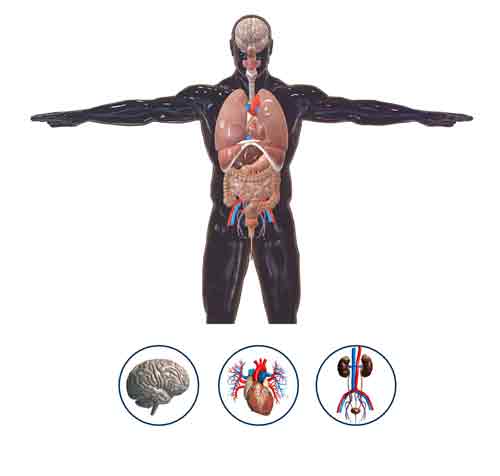
Multimedia combines five basic elements of media into the learning environment: Text, Video, Sound, Graphics and Animation, thus providing a powerful new tool for education.
All these elements are required to disseminate knowledge through Digital Content.
Some concepts require real-time Images and Videos for better understanding. Some topics are better explained using animations. Animations are of 2 types, 2 dimensional (2D) and 3 dimensional (3D). Some concepts are better explained using 3D.
In recent years, 3D entered our lives through TVs, Projectors, Monitors, and Computers etc.
3D technology is widely used in the field of education, as it command the attention of the student.

We have added 3D animations for better understanding and visualization of the imaginary concepts as per the suggestions of the Subject Matter Experts.
To start with, we have developed Human Anatomy 3D course.
What is Human Anatomy: #HumanAnatomy , is the branch of science that investigates the structure of the humans body. in this video, ( Human Anatomy Vital Organs of the #HumanBrain ( Part #1 ) you'll find the complete explanation about main parts name of human body's parts, types of anatomy and Five most important organs systems in the Human body, Vital Organs Human Brain, and Structure and its Functions using with 3D Animations and example pictures.
Vital Organs of the Human Body - They are the Brain, Heart, Kidneys, Liver, Lungs and their functions: These are the five most important organs in the Human body through these a person needs to survive. Belowe a brief about thier working and its function, given below.
(eyes, ears, nose, tongue, and skin) These five sense organs help to receive and process information about the outside world around us, and the senses Nerves relay the signals to the brain.
Learn about Human Anatomy - Organ Systems of the Human Body: The main systems of the human body are namely: circulatory system, respiratory system, digestive system, excretory system, the nervous system, immune system, Reproduction system, and the muscular system,. These are nine major organ systems in the human body.
What is Human Digestive System and How it works: The digestive system consists of a series of connected organs that together allow the body to break down and absorb food and remove waste. It includes the mouth esophagus, stomach, small inte stain, large inte stain rectum, and an. Deliver and the pancreas play an important role in the digestive system because they produce digestive juices to help you understand how different parts of the digestive system work together.
Excretory System: Excretion is the process of removing waste and excess water from the body. It is one of the major ways the body maintains homeo status, organs of excretion makeup Thele system. They include the urinary system, large stain liver skin. And. Human body works like a machine, many life processes go on continuously through these substances. Many harmful substances are produced. These unwanted substances produced from different parts of the body are sent out through the process called the "excretory system".
Nervous System: The nervous system controls both voluntary reactions, like conscious movement and invol reactions, like breathing and sense signals to different parts of the body.
Central Nervous System (CNS): The central nervous system includes the brain and the spinal cord. The peripheral nervous system consists of nerve. That connect every other part of the body to the central nervous system, central nervous system brain.
Peripheral Nervous System (PNS): The peripheral nervous system, consists of the nerve and ganglia outside of the brain and spinal cord. The main function of the PS is to connect the central nervous system.
Immune System: The immune system is the body's defense against bacteria viruses and other pathogens that may be harmful. The immune system is also known as the lymphatic system. It's main job is to make and move lymph a clear fluid that contains white blood cells, which helps the body fight infection.
Definition of Human Reproduction System: The reproductive system of the human body can be aid, either male or female, the male reproductive system, synthesizes gamut called sperm that are responsible for fertilizing the female gamut or U suicides during reproduction. The free male reproductive system is designed to undergo conception, gestation and bird once a sperm Tojo, one fertilizes, and the male reproductive system is composed of the epi D ness, vast difference, urethra pains, test scum and prostate.
Muscular System Anatomy, & Function: The muscular system is responsible for the movement of the human body. The body's muscular system consists of about six 50 muzzles that aid in movement, blood flow, and other bodily functions, muzzle source, special type of tissues of human body. That poses the ability of contraction and relaxation.
Let us observe the coordination of internal organ system in a human body. Each system depends on the others either directly or indirectly to keep the body functioning. Normally groups of organ systems work together to make complete functional organisms like us. To understand this concept. We analyze how digestive system is coordinated with other systems.